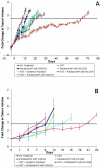Radiation-induced tumor neoantigens: imaging and therapeutic implications
- PMID: 21969260
- PMCID: PMC3180059
Radiation-induced tumor neoantigens: imaging and therapeutic implications
Abstract
Exposure of tumor cells to ionizing radiation (IR) is widely known to induce a number of cellular changes. One way that IR can affect tumor cells is through the development of neoantigens which are new molecules that tumor cells express at the cell membrane following some insult or change to the cell. There have been numerous reports in the literature of changes in both tumor and tumor vasculature cell surface molecule expression following treatment with IR. The usefulness of neoantigens for imaging and therapeutic applications lies in the fact that they are differentially expressed on the surface of irradiated tumor cells to a greater extent than on normal tissues. This differential expression provides a mechanism by which tumor cells can be "marked" by radiation for further targeting. Drug delivery vehicles or imaging agents conjugated to ligands that recognize and interact with the neoantigens can help to improve tumor-specific targeting and reduce systemic toxicity with cancer drugs. This article provides a review of the molecules that have been reported to be expressed on the surface of tumor cells in response to IR either in vivo or in vitro. Additionally, we provide a discussion of some of the methods used in the identification of these antigens and applications for their use in drug delivery and imaging.
Figures


Similar articles
-
Radiation-induced neoantigens broaden the immunotherapeutic window of cancers with low mutational loads.Proc Natl Acad Sci U S A. 2021 Jun 15;118(24):e2102611118. doi: 10.1073/pnas.2102611118. Proc Natl Acad Sci U S A. 2021. PMID: 34099555 Free PMC article.
-
Targeting drug delivery to radiation-induced neoantigens in tumor microvasculature.J Control Release. 2001 Jul 6;74(1-3):183-91. doi: 10.1016/s0168-3659(01)00335-2. J Control Release. 2001. PMID: 11489494
-
Development of neoantigens: from identification in cancer cells to application in cancer vaccines.Expert Rev Vaccines. 2022 Jul;21(7):941-955. doi: 10.1080/14760584.2021.1951246. Epub 2021 Jul 19. Expert Rev Vaccines. 2022. PMID: 34196590 Review.
-
Abscopal Effect and Drug-Induced Xenogenization: A Strategic Alliance in Cancer Treatment?Int J Mol Sci. 2021 Oct 1;22(19):10672. doi: 10.3390/ijms221910672. Int J Mol Sci. 2021. PMID: 34639014 Free PMC article. Review.
-
Therapeutic Vaccines Targeting Neoantigens to Induce T-Cell Immunity against Cancers.Pharmaceutics. 2022 Apr 15;14(4):867. doi: 10.3390/pharmaceutics14040867. Pharmaceutics. 2022. PMID: 35456701 Free PMC article. Review.
Cited by
-
Immunotherapy and radiotherapy in melanoma: a multidisciplinary comprehensive review.Hum Vaccin Immunother. 2022 May 31;18(3):1903827. doi: 10.1080/21645515.2021.1903827. Epub 2021 Apr 13. Hum Vaccin Immunother. 2022. PMID: 33847208 Free PMC article. Review.
-
Supramolecular Photothermal Nanomedicine Mediated Distant Tumor Inhibition via PD-1 and TIM-3 Blockage.Front Chem. 2020 Feb 14;8:1. doi: 10.3389/fchem.2020.00001. eCollection 2020. Front Chem. 2020. PMID: 32117862 Free PMC article.
-
Integration of stereotactic radiosurgery or whole brain radiation therapy with immunotherapy for treatment of brain metastases.Chin J Cancer Res. 2020 Aug;32(4):448-466. doi: 10.21147/j.issn.1000-9604.2020.04.03. Chin J Cancer Res. 2020. PMID: 32963458 Free PMC article.
-
Ipilimumab and radiation therapy for melanoma brain metastases.Cancer Med. 2013 Dec;2(6):899-906. doi: 10.1002/cam4.140. Epub 2013 Oct 10. Cancer Med. 2013. PMID: 24403263 Free PMC article.
-
No patient left behind: The promise of immune priming with epigenetic agents.Oncoimmunology. 2017 Aug 30;6(10):e1315486. doi: 10.1080/2162402X.2017.1315486. eCollection 2017. Oncoimmunology. 2017. PMID: 29123948 Free PMC article. Review.
References
-
- Hansen EK, Roach M. New York, NY: Springer; 2007. Handbook of evidence-based radiation oncology.
-
- Govindan R, Bogart J, Vokes EE. Locally advanced non-small cell lung cancer: the past, present, and future. J Thorac Oncol. 2008;3:917–928. - PubMed
-
- Gold KA, Lee HY, Kim ES. Targeted therapies in squamous cell carcinoma of the head and neck. Cancer. 2009;115:922–935. - PubMed
-
- Stupp R, Mason WP, van den Bent MJ, Weller M, Fisher B, Taphoorn MJ, Belanger K, Brandes AA, Marosi C, Bogdahn U, Curschmann J, Janzer RC, Ludwin SK, Gorlia T, Allgeier A, Lacombe D, Cairncross JG, Eisenhauer E, Mirimanoff RO. Radiotherapy plus concomitant and adjuvant temozolomide for glioblastoma. N Engl J Med. 2005;352:987–996. - PubMed
LinkOut - more resources
Full Text Sources
